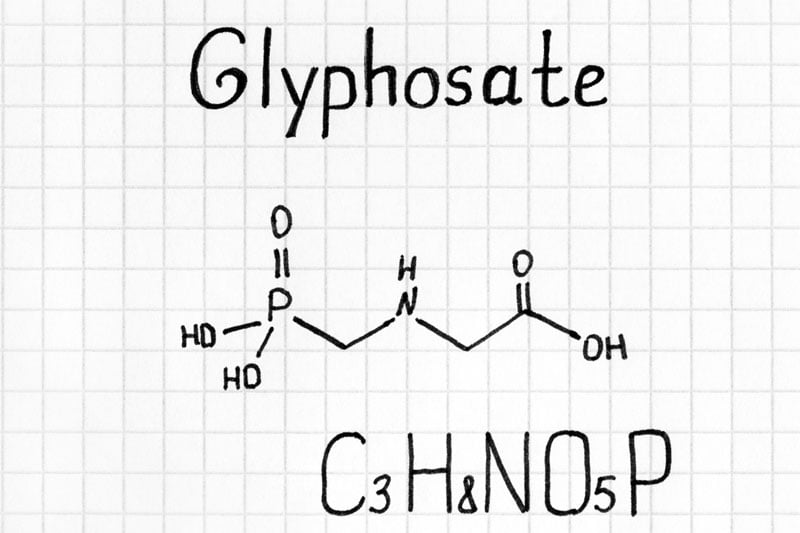As concerns escalate with regards to what kinds of chemicals and substances are situated within our food supply and thus included in our daily diet, one chemical in particular has come under increasingly intense scrutiny, Glyphosate. This post aims to explore the historical context of glyphosate, and delve into the unsettling correlation between glyphosate and cancer.
The story of glyphosate in agriculture begins in the early 1970s when the chemical was introduced as an active ingredient in the herbicide “Roundup” by Monsanto. Marketed as a revolutionary breakthrough in weed control, glyphosate offered a seemingly effective and versatile solution for many farmers, and its initial introduction was met with much enthusiasm leading to increased crop yields and simplified weed management. Over the next many decades the use of glyphosate saw an exponential growth becoming one of the most commonly used herbicides globally. The popularity of glyphosate further skyrocketed with the advent of genetically modified crops as they were now able withstand the application of glyphosate. These crops otherwise known as “roundup ready crops” allowed farmers to spray directly onto the fields without destroying the crops, this led to not only increased usage but even more direct exposure to the crops themselves.

However, the herbicide’s effectiveness led to its pervasive overuse in the industry of agriculture thus allowing the vast quantities and concentrations of glyphosate to seep into our soil, water supply, and of course our food. Over time, concerns have continued to mount over the excessive use of herbicides as well as the potential health and environmental risks we may be imposing on ourselves. A number of scientific studies conducted over the many decades of using glyphosate led to an increasing criticism and pressure on Monsanto and various regulatory bodies to reassess the use of such chemicals in agriculture.
Notable examples include a series of ecotoxicology studies conducted in the 1980s by the EPA (Environmental Protection Agency) which focused on exploring the effects of glyphosate runoff on any aquatic life in nearby areas, and found notable traces of the chemical in both the aquatic organisms and their habitats. Throughout the 1990s various studies conducted were also focusing on the soil contents including a major study conducted internationally which aimed to explore the effects on people directly working on the farms and being exposed to glyphosate. Whilst they were able to determine a number of symptoms which could be directly linked to the use of glyphosate such as skin rashes, irritation of the eye leading to slightly decreased vision, and minor lung damage. However it was also specified that many of these could be entirely mitigated by the use of appropriate and sufficient safety gear. They also failed to find any significant link between the extended exposure to high concentrations of glyphosate and cancer.

However in 2015 after a lengthy meta analysis the IARC (international Agency for Research on Cancer) had concluded glyphosate to be classed as a 2A probable human carcinogen. A declaration which further intensified the scrutiny and criticism over the continued use of such herbicides in agriculture. Criticism also emerged of the regulations, monitoring and testing done on food products which have seen the use of these herbicides as many feel they are nowhere near rigid or strict enough to ensure the safety of those eating said food products.
Looking back to more recent times Monsanto the creators and producers of glyphosate or “Roundup” controversially were acquired by another large agrochemical and seed company Bayer. This saw the two largest agrochemical and seed companies in the world join forces which some described as the creation of a near monopoly. However with the completion of Bayer’s acquisition of Monsanto, Bayer also takes on the liability for any damages caused by Monsanto products, namely Roundup. The declaration of Glyphosate as a probable carcinogen has opened the door to legal action against Mansanto and therefore now Bayer as well. Whilst they initially were able to win their cases and prevent a precedent from being set, this has very recently changed with a verdict in the Missouri courts where a Jury has ordered Bayer to pay 1.5 Billion to a number of victims after it was determined that Glyphosate could be considered as a causal factor in their Non Hodgkin’s Lymphoma. This case is seen a potential turning point as after 5 years of litigation it is one of the largest payouts with regards to specifically the use of Roundup, in addition several smaller cases and payouts have also helped increase the legitimacy of the jury’s verdict and has been paramount in setting a precedent which may force Bayer and Monsanto to use cleaner and safer chemicals for fear of being drowned in lawsuits and payouts which they eventually wouldn’t be able to afford.
Email: info@bynature.vn
Website: bynature.vn




